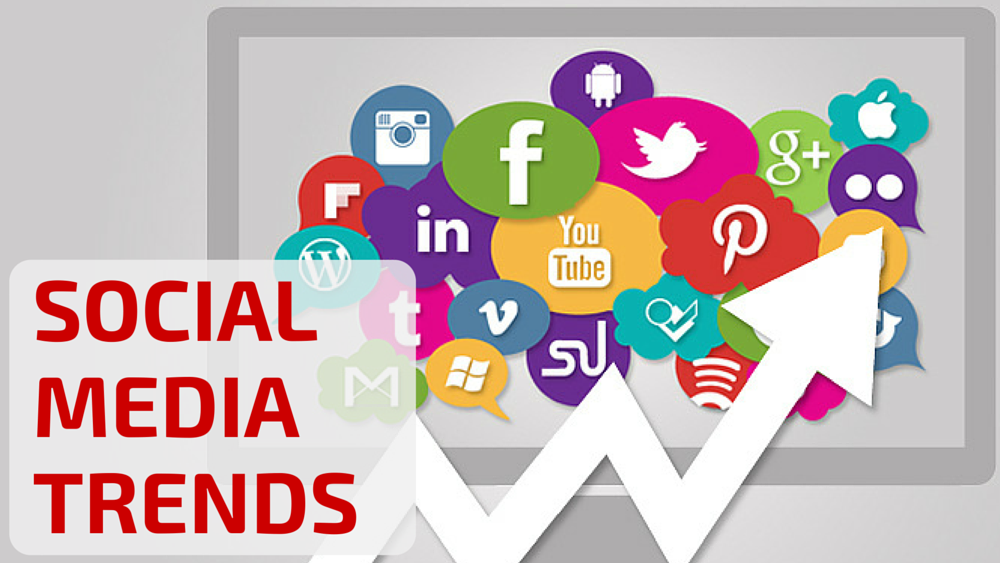Working in an industry that morphs faster than a Power Ranger can be tough — the social media landscape is always changing. If you’re wondering what’s hot, what’s not, and how to fit social media trends into your strategy… you’re definitely not alone. But, don’t worry, we have answers.
In 2022, social media will continue to evolve and change. We expect to see more digital communities being built, as well as more live streaming. Brands and businesses will continue to find new ways to sell their products and services through social media, and the simple status update will be a thing of the past.
That said, let’s keep an eye out for the social media trends to leverage in 2022 and beyond:
1. TikTok will still remain the most important social network for marketing

Instagram has held the #1 spot in most social marketers’ hearts for the past few years. It was growing the fastest, had the highest returns on investment (depending on your industry), and (bonus) was pretty fun to hang out on. But that’s changing now.
TikTok surpassed the 1 billion user mark in September 2021. That made it the 7th most popular social network in the world. If you exclude messaging networks, TikTok is the 4th most popular social media network after Instagram.
Why is this a big deal? Well, in January 2021, it only had 689 million users. That’s a 45% increase in less than a year.
And this comes after its largest growth spurt of all: a global user base increase of 1,157% between 2018 and 2020.
To put this into perspective, Instagram’s monthly active users grew at a rate of 6% in 2020.
Even more interesting? Google Search Trends shows that TikTok completely dominates Instagram’s short-form video content.
Over the last year, search demand for TikTok has grown by 173%. But search demand for Instagram Reels has only grown by 22%. And it has decreased by 33% for Instagram Stories.
But despite TikTok’s rapid growth, most businesses are hesitant to invest in the network. Based off of a Social Media Trends report, only 35% of respondents said they planned on increasing their investment in TikTok in the next year. Most businesses continue to place big bets on reliable networks like Instagram and Facebook.
But that’s not the whole story. When asked which social platforms they considered most effective for reaching their business goals, 24% said TikTok. This is a 700% increase over 2020.
TikTok introduced several helpful business tools in 2020 and 2021, including business profiles, ads, and a creator marketplace. This could be why businesses are feeling more optimistic about it this year.
To-Do List: If brands aren’t flocking to TikTok yet, they will be soon. We recommend being at the front of the wave rather than behind it.
- Grab an account handle for your brand
- Explore TikTok so you can start feeling fluent on the platform and find some ideas
- Sketch out the basics of your TikTok marketing strategy
- Use a social media management tool like to easily schedule your TikToks, moderate comments, and measure your success on the platform from one handy dashboard.
2. Companies Will Make More Dedicated Social Media Hire in 2022

It’s hard to imagine a successful digital marketing campaign without a social media strategy.
The day when marketers and businesses only used social media for brand awareness is long gone. Nowadays, social media also doubles as a powerful revenue-generating tool.
79% of consumers say user-generated content has significantly helped them improve their purchase decisions.
That’s why campaigns aren’t just hiring digital marketers that can handle social media on the side. They’re hiring dedicated social media marketers.
Most of these companies are beginning to prioritise social media.
As Aytekin Tank, Jotform founder and CEO, puts it, in 2022, there will be more companies hiring dedicated social media marketers.
Companies have been handing their social media to committees or passing them off to marketing generalists. The problem with this is that their social media doesn’t get prioritised. Instead, we have companies missing out on the opportunity to optimise their platforms and turn them into revenue generators.
A dedicated social media manager has only one task: to grow your platform, keep tabs on your social analytics, experiment with new trends and platforms, and be part of industry-specific conversations.
The whole point is that your audience is on social media, and they’re eagerly waiting to engage with your brand. You have to figure out how and act accordingly.
3. Influencer Marketing Will be More Mature

nfluencer marketing hasn’t been well streamlined.
In most cases, getting influential people to market products hasn’t been fruitful for most marketers. But that’s about to change.
It started with the pandemic speeding up the rise of unfiltered content and everyday influencers (nano-influencers and micro-influencers).
Many people trusted influencers even more than they trusted brands. That’s why influencer marketing will be an even more vital avenue in 2022.
More businesses will adopt the use of influencers in 2022. This is especially true on platforms such as TikTok, where brands are still struggling to establish a presence.
Also, as the alignment between social media and ecommerce strengthens, we’re more likely to see influencers directly impacting business sales.
Influencer marketing has been a thing for the past few years. The only difference between influencer marketing back then and influencer marketing right now is that we’ll start seeing marketers choose influencers that make the most sense to them.
In other words, businesses will go slow on choosing celebrity influencers in favour of niche influencers.
Gaurav Sharma, CEO and founder of Attack, says you can get the results you want by getting 10 to 30 micro-influencers for at least 6 to 12 months.
When done right, this could quickly skyrocket your business growth.
4. Shoppers will expect to buy your products directly on social media

Before the pandemic, social commerce was a flashy opportunity for the most innovative businesses (mattress disruptors, eyeglass disruptors—basically you had to call yourself a disruptor before you’d let your customers shop on social).
But increased social media consumption combined with stay-at-home mandates created the perfect conditions for a social shopping explosion. Which is not going away.
eMarketer predicts social commerce will be an $80 billion industry by 2025. It’s riding the coattails of equally massive e-commerce growth (an increase of 18% in 2020 alone).
81% of shoppers were already using social media to discover new brands and research products before the pandemic. Many businesses have figured out that letting these users checkout in the same app just makes sense.
After all, navigating to a website is an extra step, which is an extra potential leak in your conversion funnel. Especially on mobile, where cart abandonment rates are high.
Most social networks have in-app shopping solutions now, including live video, and are working to provide new features to meet rising demand. But Instagram, Facebook, and Pinterest are the most popular. And TikTok, Twitter, and YouTube aren’t far behind.
5. More Businesses will Invest in Short-form and Long-form Content, as well as Live Audio Chatrooms.
Video content is increasingly popular across social media channels, particularly with the rise of short-form video content such as TikTok.
According to HubSpot, 64% of marketers plan to leverage short-form videos in 2022. Also, snackable content has proven to be more effective. So, expect to see more marketers generating brief videos that are engaging, easy to digest, and can be distributed across different social media networks.
Additionally, 89% of marketers leveraging long-form video content say they plan to increase their investment in 2022.
At MediaOne, we encourage you to consider investing in both short-term and long-term videos. Experiment with both to determine which option works best with your target audience.
In addition to that, more than half of marketers say they’ll start investing more in live audio chat rooms such as Twitter spaces or Clubhouse in 2022.
The idea is to plan how you will leverage video content in 2022. Beyond videos and posts, you must experiment with audio content to see if it sparks any interest in your buyer persona.
6. Consumers Will Prefer Snackable Content

In 2020, TikTok took the social media world by storm. Their strategy? Snackable content tailored to a user’s needs.
After analysing consumers’ preferences, Instagram decided to go big with Instagram Reels. And now, snackable content is the order of the day. From Facebook, Snapchat to TikTok and Instagram, brands are creating short snackable content to educate consumers about their products, services, and brand.
The reason?
Social media attention span has been shrinking over the years.
People don’t have the time to dig through huge chunks of text or watch long-form videos.
They want to scroll endlessly through their screens and consume as much content as possible. They quickly get bored, and the only way to get their attention is to make your content entertaining, educational, short, and straight to the point.
Here are the four forms of snackable content your brand can leverage in 2022:
- Gifs
- Memes
- Quote Graphics
- Infographics
7. You will outsource (at least some of) your engagement tactics to a Creator

The creator economy has been around for about a decade. But it boomed during the pandemic as people looked for ways to diversify their income (due to unemployment, or a sudden influx of spare time, or both).
But we’re not just talking about millionaire YouTube stars. It’s now considered common for regular folks to monetize their hobbies, create a second income stream, or find freelance work through social media too.
Hence the rise of the term “Creator.”
“Creator” encompasses both professional influencer marketers and amateur content creators — basically anyone who writes, edits, designs, and films content to publish on social media with an entrepreneurial motivation.
As of 2021, 50 million people consider themselves to be creators on social networks. And businesses are set to spend $15 billion on influencer marketing by 2022.
In the U.S. alone, 72.5% of marketers are projected to make use of influencer marketing by 2022.
Social networks are both driving and responding to this boom by adding many new native monetization tools, such as:
- TikTok’s Creator Marketplace
- Instagram’s Collabs
- Instagram’s Branded Content Ads
- Brand Collabs Manager
- YouTube Brand Connect
- Twitter’s paid Super Follows
These tools are all geared to get content creators paid, so they can keep adding value for brands and users on their chosen platforms.
Plus, they help the networks hang on to their slice of that $15 billion pie. That is until one of the thousands of third-party “creator monetization” apps that have sprung up in the last few years finally cracks the code.
To-Do List: Whatever your niche (plant fanatics, goth Harry Potter fans, ASMR receptionists, etc.), there is a creator with an already established fan base waiting to partner with you. And they’ll do a better job of creating authentic, long-term customer relationships than any brand account could ever hope to!
- Define your target audience (a.k.a. the people you want to reach) — and which platform they’re on.
- Browse creator marketplaces to make a shortlist of people who have clout with that audience.
- Get ready to pay fair rates. Even the most micro of creators know their worth and won’t be willing to work for free.
8. You won’t post anything without a social listening strategy.

During the COVID-19 pandemic, many businesses jumped on board the social listening train for the first time. They liked being able to respond in real-time to questions and conversations with their customers during a health crisis.
But as the pandemic progressed (and was buffeted by ongoing political upheaval, labor shortages, and increased resentment towards corporations), even more businesses learned that social listening could help them understand their customers’ changing preferences and avoid PR mishaps.
Most respondents said that they either somewhat or strongly agree that social listening has increased in value for their organization over the past 12 months.
We also see that Google search demand for keywords like “social listening” and “social listening tools” is up 22% year-over-year. This means that more people are on the hunt to either find out what social listening is or buy a tool for their business.
9. Rise of LinkedIn Influencers

When we talk of social media influencers, the two platforms that usually come to mind are Instagram and TikTok.
We may sometimes refer to Facebook or Twitter influencers, but we have never thought of LinkedIn influencers.
Well, that’s about to change in 2022.
First, we’ve always considered Twitter the most underrated social media platform.
But as things stand, LinkedIn is about to step up to the plate and prove that they’re just as influential as any other social media platform.
They’re now investing heavily in their content creators. From global creator programs to Creator Mode rollout, LinkedIn is purposefully making it easier for content creators to grow and share their content.
And mind you, this is just the beginning of great things to come.
They even launched their first Creator Accelerator in 2021. Jon Youshaei was among the content creators selected for the program.
So, why the sudden popularity?
It started with the pandemic and the work-from-home culture. During this time, many people realised the importance of creating a memorable personal brand outside of what they have with their company.
LinkedIn has also proven to be an excellent platform for creating visibility and showcasing thought leadership.
They also have one of the best engagement rates.
We predict more creators will shift their focus to the platform. We’re bound to see more content creators taking the platform more seriously.
More people will be growing their brands, and CEOs will be working to position themselves as industry experts.
We also expect to see less of the recycled polls asking whether interns should be paid or not. We’ve had enough of this already.
So, yes, we expect to see nothing but pure creativity on LinkedIn in the years to come.
10. Niche Facebook Experiences to Become Prominent Marketing Channels.

Facebook leads as the world’s most popular social media channel, boasting nearly 3 billion monthly active users.
But that’s not what’s keeping marketers on this platform, but the rising trend of consumers craving experiences in smaller, subcultures, and niche communities.
Unlike Twitter or Instagram, Facebook excels at offering more intimate experiences.
As a result, we expect to see brands double down on three key areas to deepen their relationship with followers and build more trust with consumers.
Facebook Groups: You should continue investing in growing your Facebook group. You also want to make sure the group is connected to your Facebook page.
The reason being Facebook has introduced numerous features that make groups more robust and appealing to both members and admins.
One of these features is the ability to create subgroups. They’ll also be introducing shopping for selling merchandise, a fundraising community, and a host of other features.
Live Audio Rooms: Facebook is gradually rolling out this feature to users. And it’s among the few of the features to take advantage of in Facebook groups.
That’s because they allow you to connect intimately with members. It’s also super-easy to use and doesn’t necessarily require one to be camera ready.
Facebook Live: Live streaming isn’t exactly a new trend. We just expect to see more people using it in 2022.
To a marketer, live videos provide an excellent opportunity to connect with your followers in real-time.
You also want to go all out on Facebook Reels if you can.





